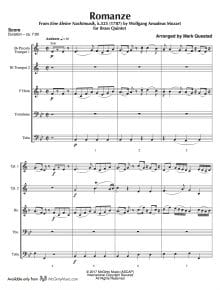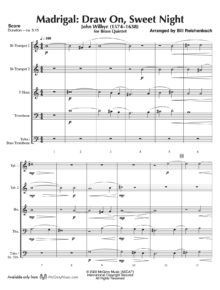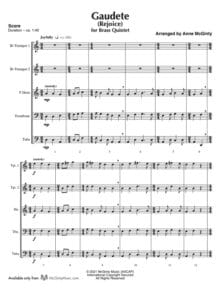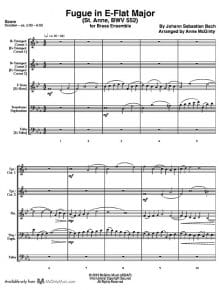Search Music
Music Categories
PDF Download Only
Purchase. Print. Play.
-
Romanze – Brass Quintet
Originally written for string quartet with an optional string bass, the Romanze is the second movement of this familiar piece and works very well for brass quintet.
The mp3 excerpt is performed by the Sine Nomine Brass Quintet. (Used with permission.)
Composer: Mark Questad
Instrumentation: 2 Bb Trumpets, F Horn, Trombone & Tuba
Duration/# of Pages: ca. 7:00 / 18 pages, 8.5″ x 11″
Key: Bb / Bbmin-Db / Bb -
Madrigal: Draw On, Sweet Night – Brass Quintet
John Wilbye (1574 – 1638) was an English composer, one of the finest madrigalists of his time. Madrigal: Draw On, Sweet Night, written over 400 years ago, is his most well known and greatest work. There is a complex array of harmonic shifts, with constant changes between minor and major. It is delicate, yet powerful, and will work well in any church setting or recital. There is an artistic unity to his writing that every audience should appreciate.
Composer: Bill Reichenbach
Instrumentation: 2 Bb Trumpets, F Horn, Trombone, Bass Trombone/Tuba
Duration/# of Pages: ca. 2:00 or 5:15 / 21 pages, 8.5″ x 11″
Key: N/A -
Gaudete – Brass Quintet
Gaudete is a 16th century Christmas carol, first published in 1582 in Finland. The carol is referred to as a medieval folk carol, and was most likely written in the late 1400s. It’s origin in unknown.
There are many notated versions of this carol, with a variety of meters. This arrangement has meters based on the Latin lyrics, thus the 3 + 3 phrasing. The stanzas are followed by a 4-bar refrain.
The title means rejoice, and the music will bring joy and great delight to your audience.
Composer: Anne McGinty
Instrumentation: 2 Bb Trumpets, F Horn, Trombone & Tuba
Duration/# of Pages: ca. 1:40 / 10 pages, 8.5″ x 11″
Key: N/A -
Fugue in E-Flat Major (J.S. Bach) – Large Brass Ensemble
“The triple fugue … is a symbol of the Trinity. The same theme recurs in three connected fugues, but each time with another personality. The first fugue is calm and majestic, with an absolutely uniform movement throughout; in the second the theme seems to be disguised, and is only occasionally recognisable in its true shape, as if to suggest the divine assumption of an earthly form; in the third, it is transformed into rushing semiquavers as if the Pentacostal wind were coming roaring from heaven.” ~ Albert Schweitzer
The Fugue in E-Flat Major (BWV 552) has become known in English-speaking countries as the “St. Anne” because of the first theme's resemblance to the St. Anne hymn O God, Our Help in Ages Past, a hymn that would have been unknown to Bach. A fugue in three sections of 36 bars, 45 bars and 36 bars, with each section a separate fugue on a different theme, it has been called a triple fugue, although only the first theme is combined with the second and third themes; for that reason the second and third sections are sometimes referred to as double fugues. The number three is pervasive and has been understood to represent the Trinity. The description of Albert Schweitzer follows the nineteenth century tradition of associating the three sections with the three different parts of the Trinity. The number three, however, occurs many other times: in the number of flats of the key signature; in the number of sections; and in the number of bars in each section, each a multiple of 3 x 3. Each of the three themes of the fugues seems to grow from the previous ones.
Written for organ, the ranges of each of the five fugal voices works well for the five brass instruments. Articulations and minimal dynamic suggestions have been added to honor the music, to make it sound as it would have sounded if the fugue were conceived for these modern instruments.
This fugue is available for brass quintet as well as brass ensemble. There are Eb trumpet parts included with the brass quintet version. The brass ensemble version has the traditional brass quintet parts, Eb trumpet parts, Eb horn, Euphonium TC and Eb tuba.
Composer: Anne McGinty
Instrumentation: 2 Bb and/or Eb Trumpets, F and/or EbHorn, Trombone and/or Euphonium & Tuba
Duration/# of Pages: ca. 5:30 / 38 pages, 8.5″ x 11″
Key: Eb




